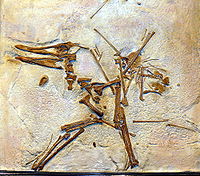- Cycnorhamphus
-
Cycnorhamphus
Temporal range: Late Jurassic
Fossil cast Scientific classification 
Kingdom: Animalia Phylum: Chordata Class: Reptilia Order: †Pterosauria Suborder: †Pterodactyloidea Family: †Gallodactylidae Subfamily: †Gallodactylinae
Fabre, 1974Genus: †Cycnorhamphus
Seeley, 1870Species: †C. suevicus Binomial name Cycnorhamphus suevicus
(Quenstedt, 1855)
[originally Pterodactylus]Synonyms Pterodactylus suevicus
Quenstedt, 1855
Pterodactylus württembergicus
Meyer, 1855
Pterodactylus eurychirus
Wagner, 1858
Gallodactylus canjuersensis
Fabre, 1974
Gallodactylus suevicus
(Quenstedt, 1855) [originally Pterodactylus]
Cycnorhamphus canjuersensis
(Fabre, 1974) [originally Gallodactylus]Cycnorhamphus (meaning "swan beak") is a genus of ctenchasmatoid pterodactyloid pterosaur from the Late Jurassic of France and Germany.[1]
In 1855 a fossil in a plate of shale from the Tithonian, found near Nusplingen in Württemberg, holotype GPIT "Orig. Quenstedt 1855, Taf. 1", was named Pterodactylus suevicus by Friedrich August Quenstedt.[2]
In 1870 Harry Govier Seeley assigned it to a new genus: Cycnorhamphus. In 1907 however, Felix Plieninger rejected this split, an opinion then shared by most paleontologists. In 1974 Jacques Fabre, when concluding that a new species found and named by him, Gallodactylus canjuersensis, was congeneric with P. suevicus, did not revive Cycnorhamphus, but judged that the latter name was unavailable because of mistakes in the diagnosis by Seeley. P. suevicus thus became Gallodactylus suevicus. However, in 1996 Christopher Bennett pointed out that such mistakes do not invalidate a name and that therefore Cycnorhamphus has priority, making Gallodactylus canjuersensis C. canjuersensis.[2] In 2010, Bennett published further re-study of the fossils, concluding that the differences between the two species could be explained by age, sex or individual variation, and formally synonymized C. canjuersensis and C. suevicus.
Cycnorhamphus had a long beak with teeth only at the tip of its jaws, possibly an adaptation to seek invertebrates in the mud. Its wingspan was about 135 centimetres.[citation needed]
See also
References

This pterosaur-related article is a stub. You can help Wikipedia by expanding it.

